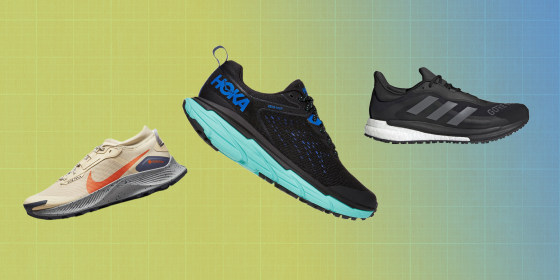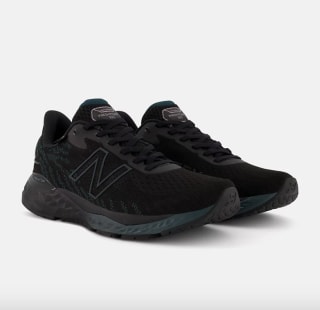According to Gopinath, some running sneakers are more effective at repelling water because they’re coated in a chemical finish or because they include fabric with a tight weave of very fine hydrophobic yarns, such as nylon or polyester. Unfortunately, a chemical finish can wear off over time and water can sometimes find its way through fabric despite a close knit — water-resistant features are not perfect, but they are helpful when it comes to preventing your sneakers from becoming waterlogged.
In addition to what material a sneaker’s sole is made from, Felsenthal suggested looking for features that add traction while running in wet conditions. For example, some sneakers are equipped with textured soles to add extra grip. Gopinath also said water-resistant sneakers need to have strongly reinforced and sealed seams to prevent moisture from soaking through even the smallest gaps, or places where different components of the shoe join, like the sole and upper.
Water-resistant shoes to shop
Since we don’t test water-resistant running sneakers, we relied on expert insights to guide our recommendations. Below, we included one expert-recommended water-resistant sneaker, as well as highly rated sneakers from Select reader favorite brands that meet expert guidance.
Adidas SolarGlide 4 GORE-TEX Shoe
Felsenthal recommended this sneaker fromAdidas, which she said is durable and comfortable during long runs and through damp terrain. It features a GORE-TEX lining, which Felsenthal noted minimizes the amount of water that enters the shoe if you’re running in wet conditions or through puddles. Adidas says the sneaker — which is available in men’s and women’s sizes — is made with recycled materials and that the outsole is built with Continental Rubber for added grip.
HOKA ONE Challenger ATR 6 GORE-TEX
ThisHOKA ONE sneaker is designed with GORE-TEX and boasts a water-resistant mesh upper, according to the brand. HOKA ONE says the shoe offers textured toe reinforcements and lugs on the outsoles to enhance durability and traction. The sneaker offers moderate cushioning, according to the brand, and it comes in men’s and women’s styles.
Nike Pegasus Trail 3 GORE-TEX
In addition to a GORE-TEX layer, this Nike sneaker offers a gaiter around the collar to help keep debris and water from getting inside the shoe. Its rubber outsole features what the brand calls a “shockwave-like pattern” and raised nubs for added traction, especially around the heel and toe areas. You can purchase the sneaker in men’s and women’s sizes.
On CloudFlyer Waterproof
On offers a variety of running shoes designed to be worn in wet weather. One popular water-resistant style is the CloudFlyer Waterproof, which the brand says boasts a windproof and waterproof membrane. The shoe, available in men’s and women’s sizes, is constructed with the brand’s Helion superfoam and a 3D-molded heel, plus includes a plush tongue and wide outsole. There are also reflective details in the heel, forefoot and laces to make you more visible if you’re running in the dark, and On says the shoe provides maximum cushioning.
New Balance Fresh Foam 880v11 GTX
The knit upper of this sneaker features GORE-TEX fabric to protect feet from moisture. It sports a dual-layer midsole that offers cushioned support, as well as a durable blown rubber outsole, according to New Balance. The sneaker comes in men’s and women’s sizes and boasts a molded heel counter and reflective details.
Is it safe to run outside in wet weather?
Before you lace up your shoes and head outdoors, Landau encouraged runners to assess just how slippery the ground may be, as running in wet conditions — especially without proper footwear — can be dangerous and poses an increased risk of injury. She said running in weather where your sneakers may end up soaked is not recommended.
“A running sneaker has the potential to absorb three times its weight in water, affecting the joints of the foot, ankle, knee, hip and back,” she said. “A mile is 2,000 steps, so every step will have three times more weight passing through the joints.”
Catch up on Select’s in-depth coverage of personal finance, tech and tools, wellness and more, and follow us on Facebook, Instagram and Twitter to stay up to date.







